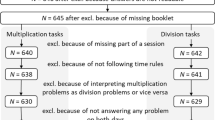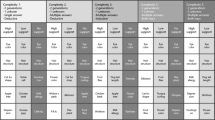Abstract
This study illustrates how a behavioral self-management intervention, which combined tactile and visual cued self-monitoring, self-graphing, and goal setting, improved the math fluency of five high school students with various disabilities during independent math practice. The intervention helped students monitor, adjust, and increase the pace at which they produced answers to simple addition and subtraction problems during daily 3-minute sessions. Using the self-management techniques, the students systematically increased the number and pace of correct responses, and concurrently, kept the number of error responses minimal and maintained or improved accuracy of responses. The paper includes recommendations for teaching students how to monitor their own academic performances rather than relying on teachers.
Similar content being viewed by others
References
Amato-Zech, N.A., Hoff, K.E, & Doepke, K.J. (2006). Increasing on-task behavior in the classroom: Extension of self-monitoring strategies. Psychology in the Schools, 43, 211–221.
Binder, C. (1993). Behavioral fluency: A new paradigm. Educational Technology, 33, 8–14.
Brophy, J., & Good, T. (1986). Teacher behavior and student achievement. In M. Wittrock (Ed.), Handbook of research on teaching (3rd edition, pp. 328–375). New York: Macmillan.
Burns, M. (2005). Using incremental rehearsal to increase fluency of single-digit multiplication facts with children identified as learning disabled in mathematics computation. Education and Treatment of Children, 28, 237–249.
Carnine, D. (1989). Designing practice activities. Journal of Learning Disabilities, 22, 603–607.
Cates, G., & Rhymer, K. (2003). Examining the relationship between mathematics anxiety and mathematics performance: An instructional hierarchy perspective. Journal of Behavioral Education, 12, 23–34.
Chiesa, M., & Robertson, A. (2000). Precision teaching and fluency training: Making math easier for pupils and teachers. Educational Psychology in Practice, 16, 297–310.
Davidson, D. (1995). Gentle reminder. Another perspective, Flagstaff, Arizona.
DiGangi, S.A., Maag, J.W., & Rutherford, R.B. (1991). Self-graphing of on-task behavior: Enhancing the reactive effects of self-monitoring of on-task behavior and academicperformance. Learning Disability Quarterly, 14, 221–230.
Flaute, A.J., Peterson, S.M., Van Norman, R.K., Riffle, T., Eakins, A. (2005). Motivate me! 20 tips for using a MotivAider to improve your classroom. Teaching Exceptional ChildrenPlus, 2, Article 3. Retrieved March 4, 2007 from http://escholarship.bc.edu/eduation/techplus/vol2/iss2/art3
Glynn, E.L., Thomas, J.D., & Shee, S.M. (1973). Behavioral self-control of on-task behavior in an elementary classroom. Journal of Applied Behavior Analysis, 6, 105–113.
Hartnedy, S., Mozzoni, M., & Fahoum, Y. (2005). The effect of fluency training on math and reading skills in neuropsychiatric diagnosis children: A multiple baseline design. Behavioral Interventions, 20, 27–36.
Johnson, K., & Street, E.M. (2004). The Morningside model of generative instruction. Concord, MA: Cambridge Center for Behavioral Studies.
Kazdin, A.E. (1982). Single-case research designs: Methods for clinical and applied settings. New York: Oxford University Press.
Krosenbergen, E.H., & Van Luit, E.H. (2004). Math interventions for children with special education needs: A meta-analysis. Remedial and Special Education, 24, 97–114.
Levinson, S., Kopari, J., & Fredstrom, J. (2002). Helping kids change their behavior: The helper’s guide to the MotivAider method. Thief River Falls, MN: Behavioral Dynamics.
Lindsley, O. (1992). Precision teaching: Discoveries and effects. Journal of Applied Behavior Analysis, 25, 51–57.
Lindsley, O. (1990). Our aims, discoveries, failures, and problems. Journal of Precision Teaching, 7, 7–17.
McDougall, D. (2005). The range-bound changing criterion design. Behavioral Interventions, 20, 1–9.
McDougall, D. (1998). Research on self-management techniques used by students with disabilities in general education settings: A descriptive review. Remedial and Special Education, 19, 310–320.
McDougall, D., & Brady, M.P. (1998). Initiating and fading self-management interventions to increase math fluency in general education classes. Exceptional Children, 64(2), 151–166.
McDougall, D., Saunders, W.M., & Goldenberg, C. (2007). Inside the black box of school reform: Explaining the how and why of change at Getting Results schools. International Journal of Disability, Development and Education, 54, 51–89.
McDougall, D., Skouge, J., Farrell, C.A., & Hoff, K. (2006). Research on self-management techniques used by students with disabilities in general education settings: A promise fulfilled? Journal of the American Academy of Special Education Professionals, 1, 36–73.
McGrew, K.S., & Woodcock, R.W. (2001). WJ III technical manual. Itasca, IL: Riverside.
McLaughlin, T.F. (1976). Self-control in the classroom. Review of Educational Research, 46, 631–663.
Meichenbaum, D. (1977). Cognitive behavior modification. New York: Plenum Press.
Morton, W.L., Heward, W.L, & Alber, S.R., (1998). When to self-correct? A comparison of two procedures on spelling performance. Journal of Behavioral Education, 8, 321–335.
O’Brien, F., & Azrin, N.H. (1970). Behavioral engineering: Control of posture by informationalfeedback. Journal of Applied Behavior Analysis, 3, 235–240.
Okyere, B.A., Heron, T.E., & Goddard, Y. (1997). Effects of self-correction on the acquisition, maintenance, and generalization of written spelling of elementary school children. Journal of Behavioral Education, 7, 51–69.
O’Leary, S.G., & Duby, D.R. (1979). Applications of self-control procedures by children: A review. Journal of Applied Behavior Analysis, 12, 449–465.
Peterson, K., & Lezotte, L. (1991). New directions in the effective schools movement. In J. Bliss, W. Firestone, & C. Richards (Eds.), Rethinking effective schools (pp. 128–137). Englewood Cliffs, NJ: Prentice Hall.
Seligson-Petscher, E., & Bailey, J.S. (2006). Effects of training, prompting, and self-monitoring on staff behavior in a classroom for students with disabilities. Journal of Applied Behavior Analysis, 3, 215–226.
Shabani, D.B., Katz, R.C., Wilder, D.A., Beauchamp, K., Taylor, C.R., & Fischer, K.J. (2002). Increasing social interactions in children with autism: Effects of a tactile prompt. Journal of Applied Behavior Analysis, 35, 79–83.
Singer-Dudek, J., & Greer, D. (2005). A long-term analysis of the relationship between fluency and the training and maintenance of complex math skills. Psychological Record, 55, 361–376.
Stecker, P., Whinnery, K., & Fuchs, L. (1996). Self-recording during unsupervised academic: effects on time spent out of class. Exceptionality, 6, 133–147.
Taylor, B.A., Hughes, C.E., Richard, E., Hoch, H., & Coello, A.R. (2004). Teaching teenagers with autism to seek assistance when lost. Journal of Applied Behavior Analysis, 37, 79–82.
Taylor, B.A., & Levin, L. (1998). Teaching a student with autism to make verbal initiations: Effects of a tactile prompt. Journal of Applied Behavior Analysis, 31, 651–654.
Watson, D.L., & Tharp, R.G. (2002). Self-directed behavior: Self-modification for personal development. Belmont, CA: Wadsworth.
Wehmeyer, M., Yeager, D., Bolding, N., Agran, M., & Hughes, C. (2003). The effects of self-regulation strategies on goal attainment for students with developmental disabilities in general education classrooms. Journal of Developmental Disabilities, 15, 79–91.
Woodcock, R.W. & Johnson, K.B. (1989). Woodcock-Johnson Psycho-Educational Battery-Revised. Allen, TX: DLM.
Woodward, J. (2006). Developing automaticity in multiplication facts: Integrating strategy instruction with timed practice drills. Learning Disability Quarterly, 29, 269–289.
Author information
Authors and Affiliations
Rights and permissions
About this article
Cite this article
Farrell, A., McDougall, D. Self-Monitoring of Pace to Improve Math Fluency of High School Students with Disabilities. Behav Analysis Practice 1, 26–35 (2008). https://doi.org/10.1007/BF03391725
Published:
Issue Date:
DOI: https://doi.org/10.1007/BF03391725




